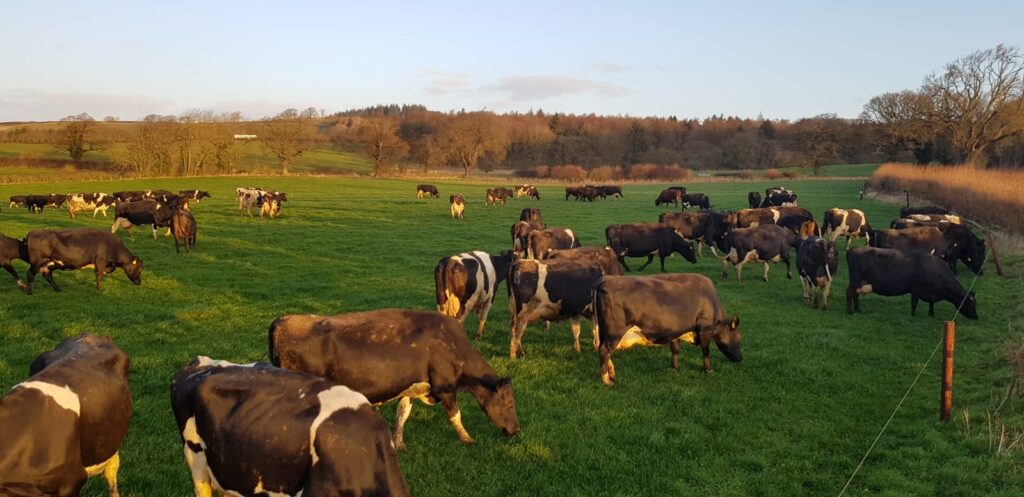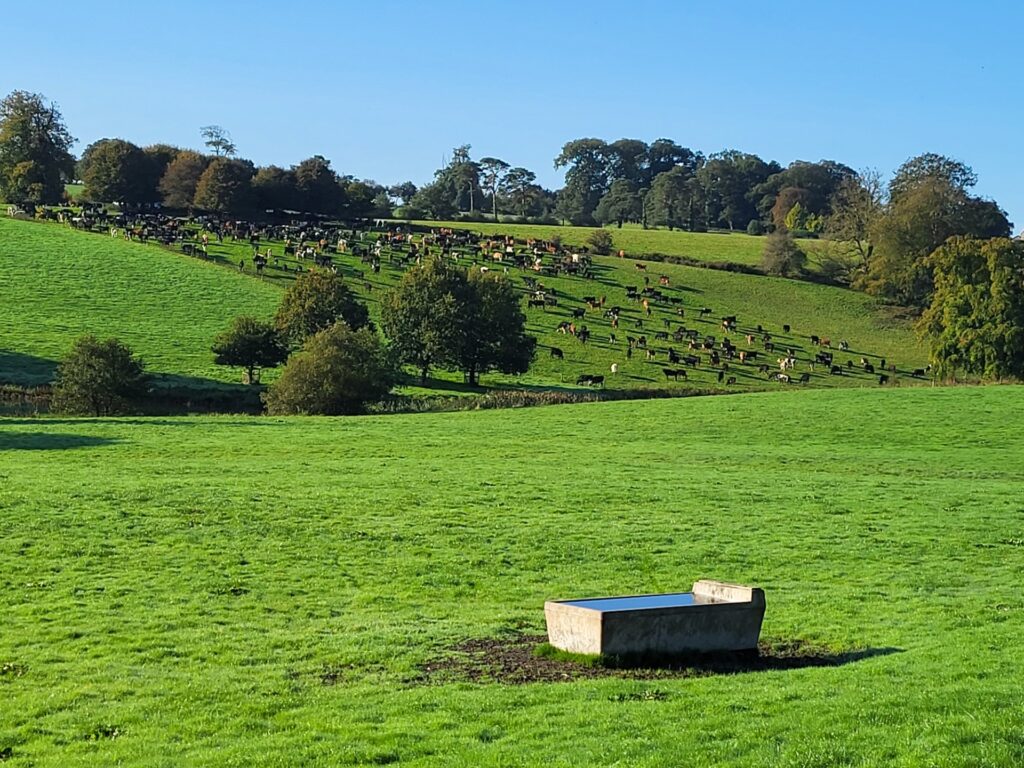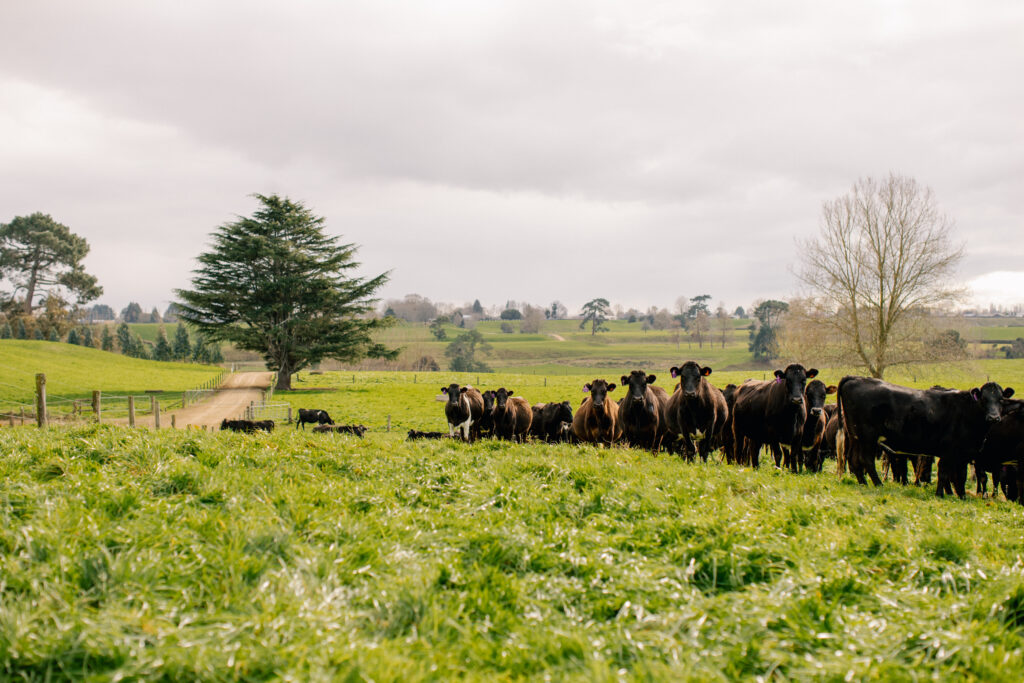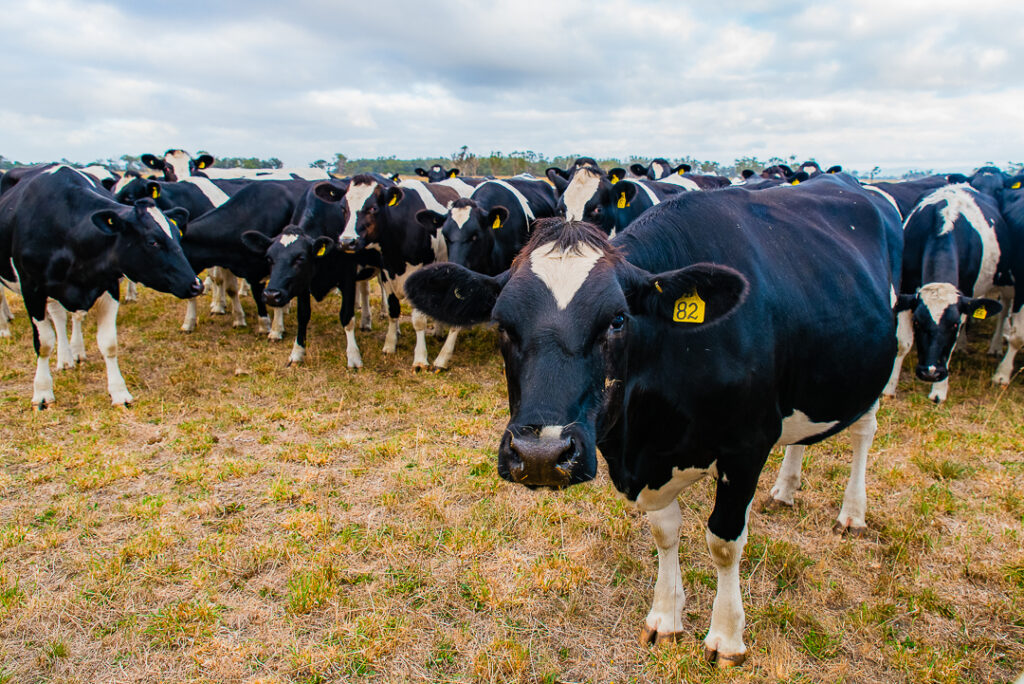Higher Greenhead Farm has been in the same family’s hands since 1981, when John and Elizabeth Thornber started with just 30 cows and 44 acres, combining farming with a milk round to support their growing family. Over the decades their son Edward took on more responsibility and they expanded to 150 acres with 120 Holstein cows. But despite their hard work, profitability remained challenging.
“Buying milk quota and land never left a lot of profit,” Edward explains. Then came what he calls their “light bulb moment” – visiting a local higher end farm successfully grazing crossbred cows with autumn calving.
The catalyst for change
The spark for change came from visits to Edward’s uncles’ farms in Scotland that had successfully implemented paddock grazing and meeting LIC Pasture to Profit Consultant Bess Jowsey at AHDB meetings. Seeing what was achievable from grazing-focused systems prompted Edward to take a fresh look at his own farm’s potential.
“We attended a couple of AHDB meetings where Bess was there,” Edward recalls. “We saw cows out grazing in early April, and we came home thinking, ‘why haven’t we got our cows out?’ That was it.”
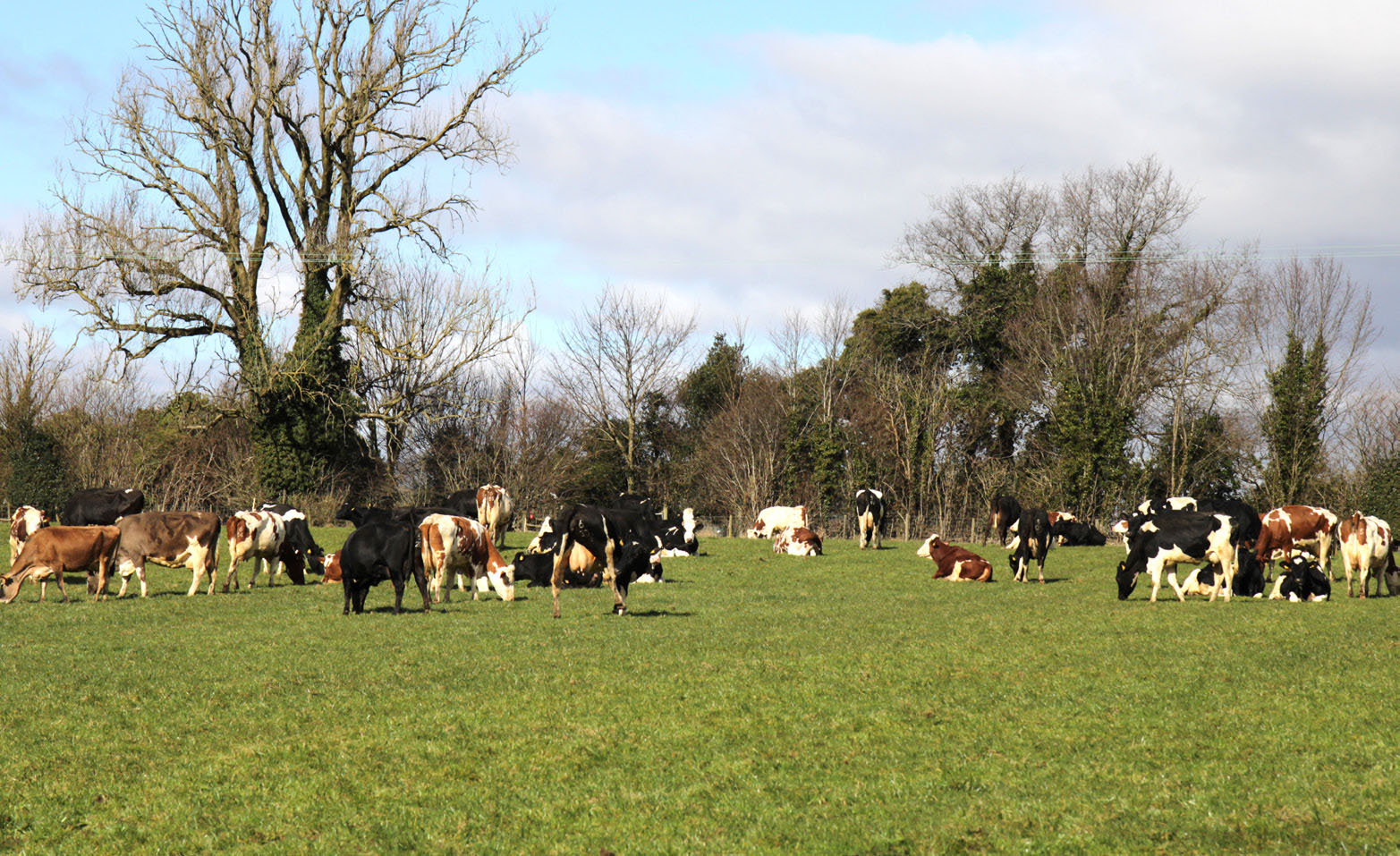
The discussion group difference
While the family had considered transitioning to autumn calving before, it was joining LIC’s Pasture to Profit dairy discussion group that truly accelerated their transformation.
“The positivity from the group gives you the confidence to try, to challenge yourself,” Edward says. “There’s no time wasters there. They’re all very motivated to help and support each other.”
Elizabeth adds, “They’re like-minded people. Even putting the milking parlour in – somebody from the group said, ‘put it the other way round,’ it’s the best thing we’ve ever done. It’s only through talking.”
This peer support proved invaluable, especially considering the significant financial investment required to update their facilities, including a new milking parlour and slurry lagoon.
“In terms of the money we spent on the milking parlour, I don’t think we would have invested as a family,” Edward admits. “But we saw the honesty of the other autumn calvers in the group and the potential profit we could make, which gave us the confidence to invest in the new setup.”
The transition journey
The transition to autumn calving was gradual and strategic. They started with a 1st September calving date, then worked to pull the finish a month earlier each year. Now, their calving period runs for 8-9 weeks starting 1st September, with heifers calving at two years.
“Early years, nothing was culled for fertility,” Edward explains. “But now, fertility isn’t an issue with the cross-breeding.”
Bess elaborates: “Initially as you’re creating a calving block, there are cows that are on the periphery that are under a lot of pressure to get back in calf very quickly. Not all of them make it. So, you’ve got to be a little bit ruthless.”
Genetics and continuous improvement
The farm now utilises a three-way crossbreeding strategy (Montbéliarde × Viking Red × Holstein) and has recently introduced LIC Jersey genetics to enhance milk solids and longevity.
“We’ve learned that breeding decisions must be data-driven, and LIC’s Herd Improvement Tool has been invaluable in helping us select the best cows for the future,” Edward explains.
One of the most valuable tools in their breeding programme has been the Herd Improvement Tool, which helped them identify their top-performing cows for their specific system.
“We had data from milk recording, the parlour computer, and the herd software,” Edward says. “Putting it all together was a nightmare, but the Herd Improvement Tool showed us simply what were our top performing cows for our system.”
“Output is vanity, profit is sanity”
The transformation has yielded impressive results across multiple fronts:
Health improvements: “I’ve had one case of mastitis all winter, and that was after a TB test,” Edward notes. “We didn’t have a milk fever last year. No twisted stomachs. The problems have gone away without pushing the cows.”
Edward also highlights that their foot trimmer, once a monthly visitor, now only needs to visit once a year!
Labour efficiency: The new parlour saves them three hours a day, and the seasonal calving pattern means concentrated periods of work followed by more manageable schedules.
Family benefits: At 70 years old, John is still fully involved in the farm but not doing 100% of the work. “It’s allowed dad to still be involved, but he’s not having to be pushed outside,” Edward says. It also affords Edward more time with his young family.
Grass management: They now use 12-hour paddocks and a platemeter to measure weekly, giving them confidence in their grass and silage management.
While milk production is around 7,000 litres per cow – less than they produced with Holsteins – the family is focused on a different metric: “Output is vanity, profit is sanity,” as Edward puts it. Though less milk may be produced, it is with less inputs so overall the farm is making more profit.
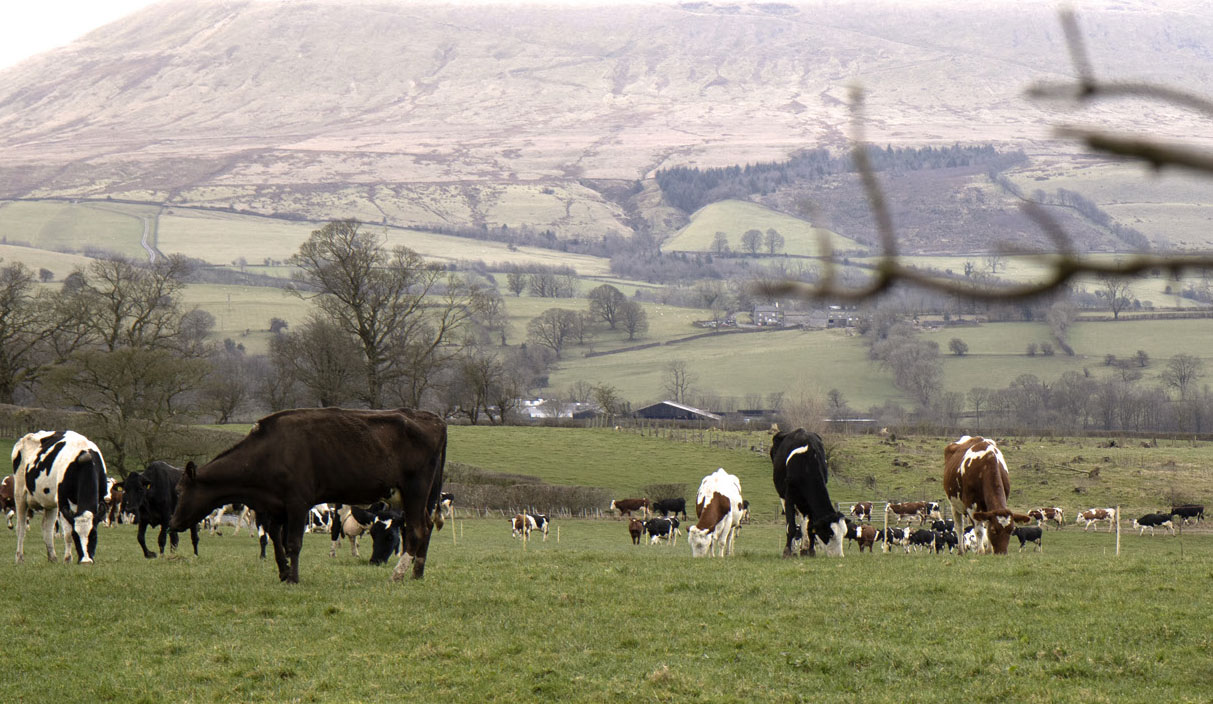
The power of peer learning
Perhaps the most valuable aspect of their journey has been the ongoing peer learning through their Pasture to Profit dairy discussion group. Meeting on the first Thursday of every month at different member farms, the group provides continuous education and support.
“Someone always tells you something that you’ve missed,” Edward says. “Something you’ve maybe walked past for the last five years, and then someone says, ‘why would you do that?’ And then you change it and it’s easier.”
The family credits LIC’s Pasture to Profit dairy discussion group as the key factor in helping them navigate and implement change successfully. The group provided:
• Benchmarking data to justify investments
• A peer support network that offered practical solutions
• Access to LIC breeding insights, ensuring the best cows are selected for their system.
Looking ahead
Higher Greenhead Farm continues to fine-tune its system, recently trialling LIC genetics on a neighbouring high performing Holstein farm and rearing the calves on his brother’s farm to allow for less competition for pasture at the home farm. Weighing heifers is next on the agenda to push performance further.
For Edward and his family, the transition has been about more than just profitability—it’s about sustainability, efficiency, and enjoying farming again.
“It’s a good work-life balance,” Elizabeth concludes. “It’s very hard from August to January, but now with the cows going out, it’s half the workload.”
“We are happy with our calving pattern now so it’s time for consolidation and to focus on production and profitability,” Edward adds.
Lessons for others
For farmers considering a similar transition, Edward offers this advice: “Some farmers just aren’t interested. They’ve got their heads down, and if they’re in a comfortable system, why should they change? But for those who are a little bit interested, the advice would be to come and have a look. Because without looking, they don’t know.”
Bess adds that this type of production system particularly benefits smaller family farms:
“Not every business has the scale to employ staff. For the size of this business, a smaller family farm where there’s competition between family life balance and having a nice farming career, that’s where I see the benefits of this type of production system really working.”
Higher Greenhead Farm shows that you don’t need to have the best facilities to have a profitable farm. “You can make do with a lot less than what other farmers have and still be profitable,” Bess explains, “Sometimes a change in system is easier than finding the capital for infrastructure investments to reach that next level.”
